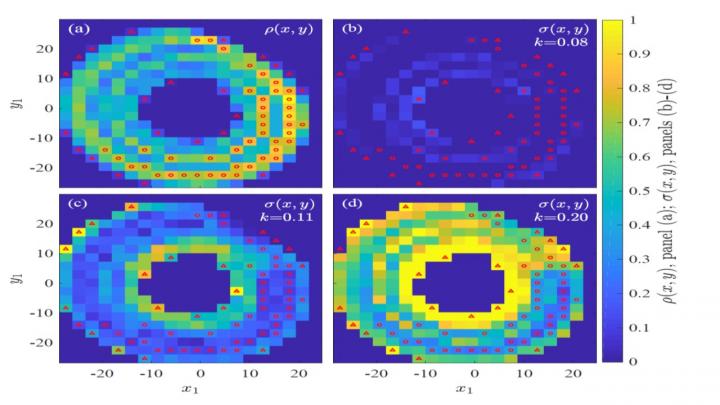Scientists reveal for first time the exact process by which chaotic systems synchronize

These shapes of donuts are the global structures of the Rossler system (named Rossler attractors). The colored points are the local synchronizations that emerged between the systems in different coupling strengths. Credit: Nir Lahav
Synchronization, in which two different systems oscillate in an identical way, underlies numerous collective phenomena observed in nature, providing an example for emergent behaviors ranging from the acoustic unison of cricket choruses to the behavior of the human brain.
Can chaotic systems also synchronize with each other? How do synchronization and self-organization emerge from systems that didn't have these properties to begin with?
Characterizing and understanding the transition from disorder to synchrony is of fundamental importance to understanding the emergence of synchronization and self-organization in nature.
In a new study published in Physical Review E, physicists from Bar-Ilan University in Israel, along with colleagues from Spain, India and Italy, analyzed the Rossler system, a well-known chaotic system which physicists have studied thoroughly for almost 40 years. Looking at this system from a fresh perspective, they discovered new phenomena that have been overlooked until now.
For the first time the researchers were able to measure the fine grain process that leads from disorder to synchrony, discovering a new kind of synchronization between chaotic systems. They call this new phenomenon Topological Synchronization. Traditionally, synchronization has been examined by comparing the time-course of activity of the two systems.
Topological Synchronization instead examines synchronization by comparing the structures of the systems. The chaotic system is therefore examined at the level of its structure, taking a more global approach to determine the process of synchronization.
“Chaotic systems, although unpredictable, still have a subtle global organization called strange attractor,” says Nir Lahav, of Bar-Ilan University's Department of Physics, the study's lead author. “Every chaotic system attracts its own unique strange attractor. By Topological Synchronization we mean that two strange attractors have the same organization and structures.
At the beginning of the synchronization process, small areas on one strange attractor have the same structure of the other attractor, meaning that they are already synced to the other attractor. At the end of the process, all the areas of one strange attractor will have the structure of the other and complete Topological Synchronization has been reached.”
The discovery of Topological Synchronization reveals that, in contrast to what was previously assumed, chaotic systems synchronize gradually through local structures that, surprisingly, kick off in the sparse areas of the system and only then spread to the more populated areas. In these sparse areas the activity is less chaotic than in other areas and, as a result, it is easier for these areas to sync relative to those that are much more erratic.
“In order to understand why this is surprising, think of this scenario: two groups of friends meet at a party. In every group we can find extroverts, who easily connect with strangers, and introverts, who find it harder to connect with a new group,” explains Lahav.
“We would assume that the first connections would occur between the extroverts and only later would the introverts create connections. It would be very surprising to see this happen the other way around. But this is exactly what we found in our results. We assumed that the dense areas of the system, where most of the activity is, would sync with each other first (like the extroverts), but in reality we discovered that the low-density areas were the first to sync (the introverts).”
This conceptual novelty pertains not only to our fundamental understanding of synchronization, but also carries direct practical implications on the predictability limits of chaotic systems. Indeed, thanks to this newly-defined local synchronization, the researchers show that the state of one system can be inferred from measurements of the other, even in the absence of global synchrony. We can predict where synchronized areas will appear in week coupling, much before complete synchronization.
The researchers are currently applying their findings to try to uncover how self-organization may emerge in other complex systems in nature such as the human brain.
Media Contact
More Information:
http://dx.doi.org/10.1103/PhysRevE.98.052204All latest news from the category: Life Sciences and Chemistry
Articles and reports from the Life Sciences and chemistry area deal with applied and basic research into modern biology, chemistry and human medicine.
Valuable information can be found on a range of life sciences fields including bacteriology, biochemistry, bionics, bioinformatics, biophysics, biotechnology, genetics, geobotany, human biology, marine biology, microbiology, molecular biology, cellular biology, zoology, bioinorganic chemistry, microchemistry and environmental chemistry.
Newest articles

Recovering phosphorus from sewage sludge ash
Chemical and heat treatment of sewage sludge can recover phosphorus in a process that could help address the problem of diminishing supplies of phosphorus ores. Valuable supplies of phosphorus could…

Efficient, sustainable and cost-effective hybrid energy storage system for modern power grids
EU project HyFlow: Over three years of research, the consortium of the EU project HyFlow has successfully developed a highly efficient, sustainable, and cost-effective hybrid energy storage system (HESS) that…

After 25 years, researchers uncover genetic cause of rare neurological disease
Some families call it a trial of faith. Others just call it a curse. The progressive neurological disease known as spinocerebellar ataxia 4 (SCA4) is a rare condition, but its…





















